Training has always been a passion of mine, actually it’s been more of an obsession. To say that I love to train would be an understatement. I need to train. Despite this obsession, it’s important for me to have a goal or at least an objective. These goals have taken several forms. The specific training for each goal differs, but certain similarities run through all such goals. Of all the challenges I’ve undertaken, training to become a Navy SEAL definitely stands out. BUD/S (Basic Underwater Demolition/SEAL) training is some of the most difficult military training in the world. It’s important to train correctly prior to showing up.
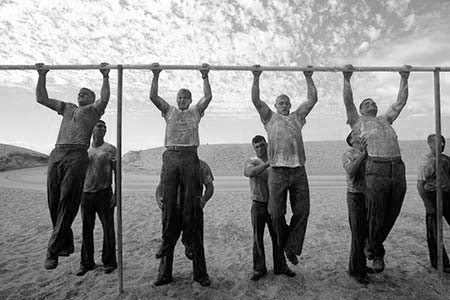
How Did I Prepare?
At first, I wasn’t sure what to do. I enlisted in the Navy in 1998 and back then, you couldn’t search the internet for training plans like Stew Smith now has and the Discovery Channel had no specials on BUD/S. There were a few books written by Vietnam-era frogmen which I devoured, along with the occasional magazine article.
My recruiter knew very little about the SEAL Teams and even less about how to train for BUD/S, but he did give the “BUD/S Warning Order.” This printed document (now available online) became my roadmap. I read it all and followed it to the letter. I’ll spare you the details, you can check out the link for yourself but in essence the plan consisted of lots of running, swimming, and simple bodyweight exercises. It was pretty much a linear progression designed to get the student up to a point where he could do so many pushups, pullups, sit-ups, dips, and run and swim certain distances in certain times. It was challenging.
What Did I Learn?
Unfortunately, I did not keep a training log, but I did follow it almost verbatim. So, I do know how I prepared. The program of running, swimming, and bodyweight exercises gradually built volume in each of these physical disciplines over time. Along the way, I learned a lot. The most powerful lessons were the power of purpose, the importance of a program, and the ability to work hard!
The power of purpose
As I said earlier, I was laser focused on graduating BUD/S and becoming a Navy SEAL. This purpose motivated me to do the work necessary to be successful. It provided extra motivation days when I didn’t feel like training or didn’t want to do my calisthenics and then do a 6-mile run. It helped me get out of bed early and jump into a cold pool just to get my laps in. Purpose is indispensable.
The importance of a program
Having a guide, like a map to follow, took the guesswork out of my training. It saved me the mental energy of building a program for myself and wondering if it would work. Of course, there were days where I couldn’t do the work out as prescribed. But, more often than not, I followed it to the letter. If my Warning Order told me to do 100 pushups, 50 pullups, 100 sit-ups, and THEN run 4miles, that’s what I did. As Pavel would say, “I don’t care how you feel, just follow the program!” Don’t reinvent the wheel.
Be ready to work hard
There is no getting around it. If you want to do something hard, you will have to work hard beforehand to be able to handle the volume of work necessary to finish the race. In an era now defined by “hacks” (shortcuts), hard work is a hard sell, but essential.
Where to Focus
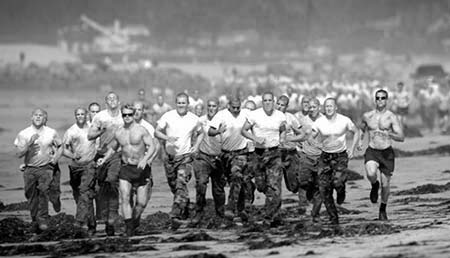
Running
I have to start with running. Running endurance and running efficiency are easily the most important aspects of SEAL training. The same is true for almost all other forms of Special Operations selection courses. Lower leg injuries such as shin splints and stress fractures are the most common injuries in BUD/S training. Thankfully, I did most of my training runs on soft gravel roads, often in boots! This wasn’t quite as difficult as doing 4-mile timed runs in soft sand, but it did prepare me better than running on the “hard ball.” It’s important to not only know the task, but also to know the conditions in which you will have to perform the task. Now, given what we know about cardio, I would recommend the exact same running program as outlined in the Warning Order and focus on getting my running technique as efficient as possible. To do that, I’d recommend using a heart rate monitor and build a very solid aerobic base by doing as much running as possible below the aerobic threshold. The end goal would be to do the same runs but do them more efficiently.
Swimming
Swimming would come next. Being a good swimmer and being comfortable in the water is a must. Most of my training swims were done in a pool. I worked up to 2-mile distances and had no problem making the time standards. Then, for the first time, I had to swim in the open ocean. Much more challenging. If I had to do it all over again, I would definitely do some longer swims in a lake to get better at guiding. Had I known about the book Total Immersion, I would have read it and worked towards being more efficient with my swims—similar to my runs. Also, and this is very important, given what we now know about shallow water blackouts I probably wouldn’t practice doing 50-yard underwater swims on my own, in a pool, without a lifeguard or anyone else in the pool.
Bodyweight
You are tested on this constantly and pushups are one of the most common forms of punishment. Towards the end of training, we had to be able to do multiple sets of 50 reps in a given day. Or even consecutively. The program laid out in the Warning Order is great. It uses pyramids to build volume. I did the pushups and sit-ups anywhere around the farm, without the benefit of a gym mat. For pullups, I used rafters in the barn or shop, thanks to inspiration from Rocky IV! That being said, if I had known about “Greasing the Groove” and “Waving the Load,” I would have incorporated both of these StrongFirst principles into my bodyweight training. It would have helped me safely build more volume and even bigger levels of strength endurance.
Kettlebells
This is one thing I’d definitely add, and I wouldn’t add much. Mostly, I’d use the kettlebell to augment the bodyweight resistance training. Specifically, I’d add some get-ups and some overhead presses, all with a light weight. This would have helped better prepare me for the fun known as Log PT! (For those unfamiliar with the concept of ‘Log PT’, it’s simply doing a bunch of exercises as a group with a heavy log, mostly held overhead.) What about kettlebell ballistics? Personally, I think these are the most valuable kettlebell exercises. That said, I’d hold off on adding them until after selection training. I would use kettlebell ballistics to prepare me for combat deployments, and other such adventures, but not for selection. There isn’t enough time and running, swimming, and body weight exercises are more important.
Breathing
Now it’s all the rage but back then, not many people were talking about this. I’d definitely add it to the program. There are many great places to find information, and further explanation would be outside the scope of this article. I’ve found breath work not just to be great physically, but also mentally.
Rucking
Oddly, there is very little rucking in BUD/S until you get to third phase. Then, it’s introduced with a vengeance. At this point, you are already in great shape from the running, swimming, and bodyweight training. So, rucking, at first, isn’t that big of a deal. After BUD/S, rucking becomes much more important. Being able to move under load becomes much more important in SQT (SEAL Qualification Training) and even more when you join your team. It’s important but add it carefully. But not at the expense of the running and bodyweight training. Of course, I did significant rucking before deployments and big expeditions.
Recovery
Thankfully, I couldn’t really measure my HRV (Heart Rate Variability as an objective measurement of your recovery). If I had, it probably would have told me I couldn’t train that day! That said, I would now take my recovery more seriously. I’d definitely stretch every night, as well as use things like foam rollers, lacrosse balls, and massage sticks.
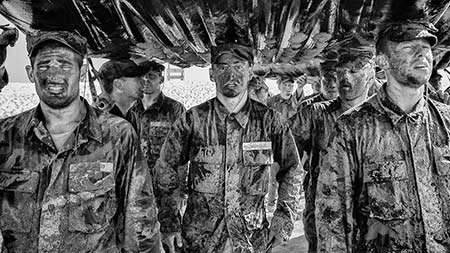
Overtraining
Be very careful not to show up to BUD/S, or any military selection in a state of overtraining! You will not have time to heal yourself during any form of hard, selection style training. In fact, I will usually advise people to err on the side of doing less than more. As Dan John once said, “More is not better, it’s just more.”
Selection vs Combat training
Different from selection training, when preparing for a combat tour, you have to train differently. I won’t dive into specifics for this article, but the program or protocol would be much different. You would build this program around a different objective. The objective being simple: to be as physically capable as possible for the upcoming deployment. How do we do that? That’s a topic for another day. One thing is certain: you would NOT want to follow a program with so much volume (or intensity) that it left you weaker or less conditioned than when you started. Again, opt for doing too little over too much. Make yourself stronger and be able to move around under load. A lot!
Conclusion
It’s good to have challenging, but achievable goals. They give you purpose in your training. Preparing your body for the rigors of a selection will require lots of hard work. If you succeed, you will simply be more prepared than others to then go suffer the real challenge of selection training. It could be Ranger School, Special Forces Selection, Marine Recon Selection, or even BUD/S. All of these are worthy goals and all of them prove the StrongFirst maxim, “Strength has a greater purpose.”
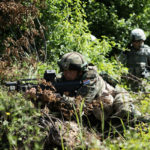
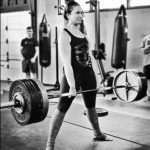
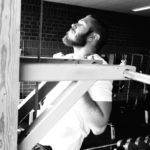


Great article. I am actually preparing to try out for BUD/s as well. This definitely cleared up a lot of confusion with all of those prep programs out there nowadays. I am curious your thoughts on doing GTG with push ups/pull ups and then keeping the ROP program as your main workout or vice versa. Main workout being the calisthenics mentioned in the warning order and GTG with get ups and clean and press. Thanks!
I think that could work. Just be sure that high-rep, body-weight calesthenics are THE focus of your strength training. Adding some get-ups will help w/injury prevention. I think clean & press is a good one too, just be sure it does NOT interfere w/your push-up training. When in doubt, do a little bit less. Always better to show up slightly undertrained than slightly overtrained! You won’t recover there!
Will do. Appreciate the response sir!
Great article.
Great article. You could write also article about how you train these days to stay in great shape?
Personally I think too that running, rucking, swimming, push ups, sit ups and pull ups are pretty much universal when training for military. Those were tested also in Finnish army. If I remember correctly they tested also back extensions and standing long jump.
All I would add to this excellent piece is that when it comes to such selection courses, there is only so much PT a candidate can do before it all boils down to how much he’s willing to put up with. In both my attempts at BUD/S, our best athletes tended to quit within the first week after classing up.
Eric, thank you for a great article, and for your service to our country.
“Purpose is indispensable.”
Well said, sir.